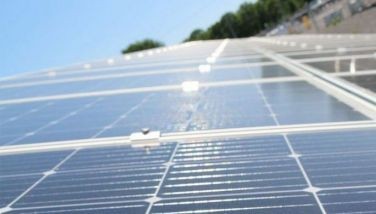Sugarmen decry lower fructose tariff
March 26, 2002 | 12:00am
Sugar producers are asking government to retain the present tariff level on fructose imports by the pharmaceutical industry but are proposing that high duties be levied on imports by other sectors.
They warned that while import levels of fructose at present are still manageable, government’s decision to bring down fructose tariffs to seven percent will open the floodgates to cheap imports, not only of high fructose syrup, but also raw materials used in its production, such as corn, and cassave, to the detriment of local farmers.
The Philippine Sugar Millers Association (PSMA) said in a briefing yesterday that they are seeking the creation by the Tariff Commission of a new eight-digit tariff line for fructose, as in the United States.
This will allow the setting of different tariff rates for its different applications or use without adversely affecting existing users, like the pharmaceutical industry.
The sugar industry was caught by surprise when government, during the time of former President Joseph Estrada, unilaterally brought down the tariff of fructose from 50 percent to seven percent, without prior consultation and public hearing. It was only recently that the industry learned of the reduction.
The PSMA noted that it is a common practice in other sugar-producing countries that detailed setting of tariff, such as for various uses of a particular product, is made at the eight-digit tariff level.
Right now, there is a six-digit tariff lien for fructose (1702.60), which sets a seven percent import duty for imports of fructose.
The group is proposing an eight-digit subclassification, such as 1702.60.10 that will allow a seven percent tariff for imports by pharmaceuticals, and 1702.60.20 that will impose a 50 percent tariff for imports by other users, like the beverage industry.
According to PSMA resident sugar technologist Oscar Cortez, the pharmaceutical industry imports around 20,000 metric tons of fructose, in particular high fructose corn syrup (HFCS).
Fructose in its pure form is 1.3 to 1.8 times sweeter than sugar and is commonly called "fruit sugar" it is the most abundant sugar present in fruits.
However, the fructose that is being traded and produced in commercial quantities and used as food ingredients or sweetener comes from carbohydrates/starches, primarily those found in corn.
The most common forms used are HFCS (55 percent fructose) which is as sweet as sugar, and HFCS-42 (42 percent fructose) which is roughly 90 percent as sweet as sugar. It is used in softdrinks (primarily in the US), bakery products, canned fruits, canned juices, condiments, confectionery products, frozen desserts, jams, jellies, preserves, and wine production.
PSMA noted that HFCS would displace cane sugar as a sweetener in various products such as softdrinks (whose annual sugar demand is 277,200 metric tons), fruit juices (78,000 tons), frozen desserts (19,500 tons) and canned/bottled preserves (11,800 tons) for a total of 386,500 tons valued at P6.57 billion.
It said that the influx of a cheap sugar substitute into the domestic market would depress local prices of sugar to a level not viable to farmers.
They warned that while import levels of fructose at present are still manageable, government’s decision to bring down fructose tariffs to seven percent will open the floodgates to cheap imports, not only of high fructose syrup, but also raw materials used in its production, such as corn, and cassave, to the detriment of local farmers.
The Philippine Sugar Millers Association (PSMA) said in a briefing yesterday that they are seeking the creation by the Tariff Commission of a new eight-digit tariff line for fructose, as in the United States.
This will allow the setting of different tariff rates for its different applications or use without adversely affecting existing users, like the pharmaceutical industry.
The sugar industry was caught by surprise when government, during the time of former President Joseph Estrada, unilaterally brought down the tariff of fructose from 50 percent to seven percent, without prior consultation and public hearing. It was only recently that the industry learned of the reduction.
The PSMA noted that it is a common practice in other sugar-producing countries that detailed setting of tariff, such as for various uses of a particular product, is made at the eight-digit tariff level.
Right now, there is a six-digit tariff lien for fructose (1702.60), which sets a seven percent import duty for imports of fructose.
The group is proposing an eight-digit subclassification, such as 1702.60.10 that will allow a seven percent tariff for imports by pharmaceuticals, and 1702.60.20 that will impose a 50 percent tariff for imports by other users, like the beverage industry.
According to PSMA resident sugar technologist Oscar Cortez, the pharmaceutical industry imports around 20,000 metric tons of fructose, in particular high fructose corn syrup (HFCS).
Fructose in its pure form is 1.3 to 1.8 times sweeter than sugar and is commonly called "fruit sugar" it is the most abundant sugar present in fruits.
However, the fructose that is being traded and produced in commercial quantities and used as food ingredients or sweetener comes from carbohydrates/starches, primarily those found in corn.
The most common forms used are HFCS (55 percent fructose) which is as sweet as sugar, and HFCS-42 (42 percent fructose) which is roughly 90 percent as sweet as sugar. It is used in softdrinks (primarily in the US), bakery products, canned fruits, canned juices, condiments, confectionery products, frozen desserts, jams, jellies, preserves, and wine production.
PSMA noted that HFCS would displace cane sugar as a sweetener in various products such as softdrinks (whose annual sugar demand is 277,200 metric tons), fruit juices (78,000 tons), frozen desserts (19,500 tons) and canned/bottled preserves (11,800 tons) for a total of 386,500 tons valued at P6.57 billion.
It said that the influx of a cheap sugar substitute into the domestic market would depress local prices of sugar to a level not viable to farmers.
BrandSpace Articles
<
>
- Latest
- Trending
Trending
Latest
Trending
Latest
Recommended



























